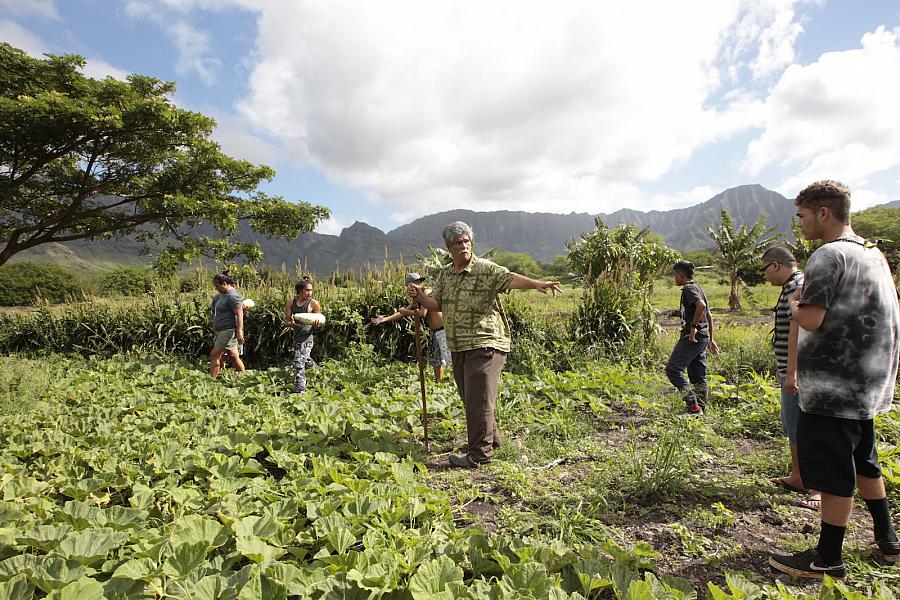Lessons from reporting on Hawaii’s racially uneven foster care system

Cultural practitioner Wayde Hoapili Lee, center, explains traditional Hawaiian agricultural techniques to youth enrolled in his 21-day residential program. Photo by Krystle Marcellus.
One of the biggest challenges in reporting my series “Hawaiians at Risk” for the Honolulu Star-Advertiser was trying to nail down a widespread perception of bias in the child welfare system among the Hawaiian parents I spoke to.
They all described a system, which is cloaked in confidentiality, as being biased against Hawaiians, yet they had trouble providing solid examples. The parents’ main point was that, if all else were equal, the system’s social workers were more inclined to recommend removing Hawaiian children from their families than non-Hawaiian children.
State data and the one research report I found that examined the notion of bias in Hawaii’s system tended to support the parents’ claims.
I spent hours sitting in on three different programs that use Hawaiian cultural practices to help strengthen families involved in the child welfare or juvenile justice systems. While two of them dealt specifically with the former, the one program that I highlighted — Wayde Lee’s 21-day residential program — was born out of overrepresentation in the juvenile justice system.
I chose to highlight the program because it had the most compelling elements, and I was able to observe one group of boys go through it from start to finish.
And while my project focused mostly on the foster system, the essence of Lee’s initiative reflected the same basic approach underlying all the programs. They use aspects of traditional Hawaiian culture as teaching tools to help youth and their families — mostly Hawaiian — reconnect with the past and, in theory, become better equipped to build stronger, healthier relationships. Yet the approach is designed to help all families, regardless of race.
While racial disproportionality is not unique to Hawaii’s child welfare system, the colonial history of Hawaii’s indigenous people provides a unique framework from which to view the problem. What might be effective in addressing the overrepresentation of certain racial groups in mainland communities will not necessarily work in Hawaii, according to the Hawaiian cultural practitioners I spoke to.
Despite that difference, there are some lessons learned that I can share with others considering examining such disparities in their communities:
- If you work for a mainstream media outlet, partner with an ethnic-owned outlet that covers the racial group the project is about. At a minimum, that should broaden the reach of your project, especially among the people most affected. And depending on the extent of the collaboration, the partnership can lead to more nuanced reporting and to coverage areas that you otherwise might not have considered.
- Because accusations of bias are hard to pin down in a child welfare system steeped in confidentiality, good data and peer-reviewed research is critical. Much of the latter literature focuses on the overrepresentation of blacks and Native Americans in child welfare systems. Also, be leery of data that originates from small samples. I intended to show disproportionality by island, but the census numbers for the less populated ones were not reliable enough to use.
- Look for success stories to balance the doom and gloom you might find in the data. The most popular part of our project was the uplifting tale of how a Hawaiian father with a long history of criminal offenses, substance abuse and domestic upheaval was able to turn his life around and be reunited with his six children.
In response to the series, Richard Wexler, executive director of the Virginia-based National Coalition for Child Protection Reform, wrote an op-ed column that applauded the coverage while noting that racial bias plays an important role in the needless removal of Native Hawaiian, African-American and Native American children from their families across the country.
But he also cited positive trends within Hawaii’s child welfare system to dramatically reduce the overall foster population over the past decade. Wrote Wexler:
“That track record, the kind of excellent journalism reflected in the Star-Advertiser story and the heightened activism among Native Hawaiians mentioned in the story give hope that Hawaii will come to grips with the needless placement of Native Hawaiian children.”

